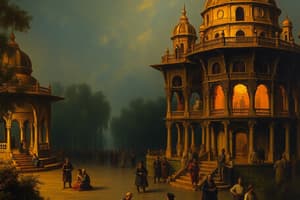Podcast
Questions and Answers
What major decision did Muhammad-bin Tughluq regret shortly after implementing it?
What major decision did Muhammad-bin Tughluq regret shortly after implementing it?
- Attempting to control the Mongols directly
- Shifting the capital from Delhi to Daulatabad (correct)
- Increasing taxes in the Ganga-Yamuna Doab
- Establishing a department for agriculture
What significant event occurred after Ghiyasuddin's death in AD 1287?
What significant event occurred after Ghiyasuddin's death in AD 1287?
- A long-lasting peace was established in the Sultanate.
- Mongol invasions successfully took control of the region.
- Jalaluddin Khalji was appointed as the heir to the throne.
- The Khalji dynasty began its rise to power. (correct)
What consequence did the heavy taxation during a famine lead to for the peasants?
What consequence did the heavy taxation during a famine lead to for the peasants?
- Increased agricultural production
- Successful revolts against the Sultan
- A decrease in the Sultan's army size
- The abandonment of lands by many peasants (correct)
What misconception did Muhammad-bin Tughluq have regarding the location of Daulatabad?
What misconception did Muhammad-bin Tughluq have regarding the location of Daulatabad?
How did Jalaluddin Khalji's rule differ from that of his nephew Alauddin Khalji?
How did Jalaluddin Khalji's rule differ from that of his nephew Alauddin Khalji?
Which historian documented the policies and actions of Muhammad-bin Tughluq during his rule?
Which historian documented the policies and actions of Muhammad-bin Tughluq during his rule?
Which title did Alauddin Khalji assume that reflects his ambitions?
Which title did Alauddin Khalji assume that reflects his ambitions?
What was one of Muhammad-bin Tughluq's attempts to rectify his earlier mistakes regarding agricultural management?
What was one of Muhammad-bin Tughluq's attempts to rectify his earlier mistakes regarding agricultural management?
What approach did Alauddin Khalji take towards conquered territories?
What approach did Alauddin Khalji take towards conquered territories?
What major challenge did Alauddin Khalji face at the start of his reign?
What major challenge did Alauddin Khalji face at the start of his reign?
Flashcards are hidden until you start studying
Study Notes
The Sultanate Period Overview
- Nobles and visitors were required to prostrate (sijdah) and kiss the Sultan's feet (paibos).
- Ghiyasuddin's death in AD 1287 led to the decline of the Slave dynasty and the rise of the Khalji dynasty.
The Khalji Dynasty (AD 1290-AD 1320)
- Jalaluddin Khalji, an Afghan noble, usurped power in AD 1290 after killing Ghiyasuddin’s heir.
- Jalaluddin ruled from AD 1290 to AD 1296, known for being mild and generous.
- Successfully repelled Mongol invasions and engaged politically with Mongol leaders through marriage.
- Perceived as weak due to leniency towards nobles; assassinated by his nephew, Alauddin.
Alauddin Khalji (AD 1296-AD 1316)
- Aspired for global conquest, earning the title Sikandar-i-Sani (second Alexander).
- Expanded the Sultanate significantly, conquering regions like Gujarat, Malwa, and almost all of Rajasthan.
- First Sultan to extend influence into South India, defeating rulers of Devagiri, Warangal, and more.
- Preferred tribute over annexation; allowed defeated kings to retain power with conditions.
Muhammad-bin Tughluq's Reforms and Struggles
- Notable for failed policies that led to unrest and rebellion; faced challenges from nobles and Mongol invasions.
- Capital relocated to Devagiri (renamed Daulatabad) causing hardship and eventual return to Delhi due to ineffectiveness.
- Imposed heavy taxes during famine in Ganga-Yamuna valley, igniting peasant revolts.
- Introduced token currency made of cheap metals, leading to rampant counterfeiting and financial chaos.
Firuz Shah Tughluq (AD 1351-AD 1388)
- Renowned reformer who aimed to alleviate agricultural distress; constructed canals and irrigation systems.
- Instituted the Diwan-i-Khairat to support the needy; improved health and education through mosques, hospitals, and colleges.
- Faced challenges from increasing power of nobles and ulama; reintroduced hereditary land grants (iqtas).
- Maintained a significant number of slaves, straining financial resources, ultimately leading to the dynasty's decline.
Tughluq Administration
- Governed through bandagans and clients; appointed individuals of humble origins to important positions.
- Key figures included the wazir (revenue head), bakshi (paymaster), and qazi (chief judge).
- Relaxed rules regarding iqtas led to their hereditary nature; increased power of iqtadars over time.
The Sayyid Dynasty (AD 1414-AD 1451)
- Khizr Khan aimed to extend his rule beyond Delhi but faced difficulties maintaining control.
- Successors engaged in power struggles; Alauddin Alam Shah's rule saw the rise of Bahlul Lodi.
- In AD 1451, Bahlul Lodi established the Lodi dynasty, marking the transition to Afghan rule.
Historical Sources
- Valuable information on the Delhi Sultanate derived from coins, inscriptions, monuments, and historical texts (tawarikh) detailing significant events.
Studying That Suits You
Use AI to generate personalized quizzes and flashcards to suit your learning preferences.




